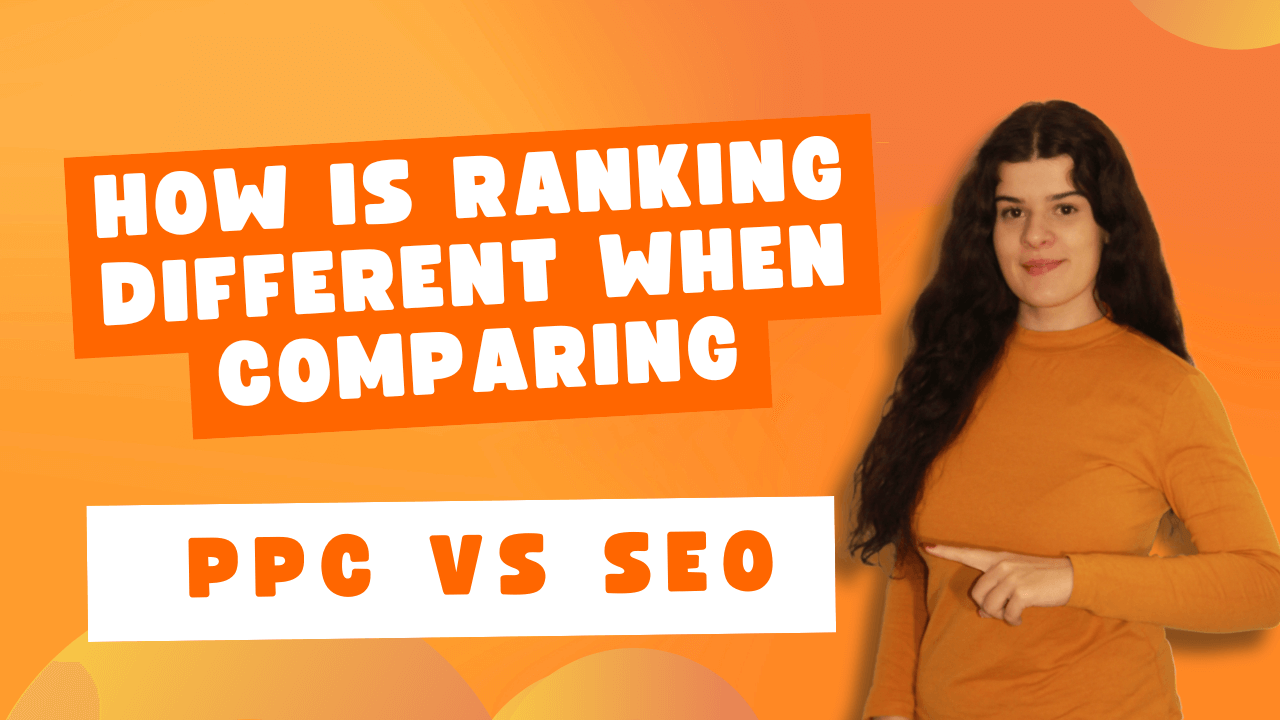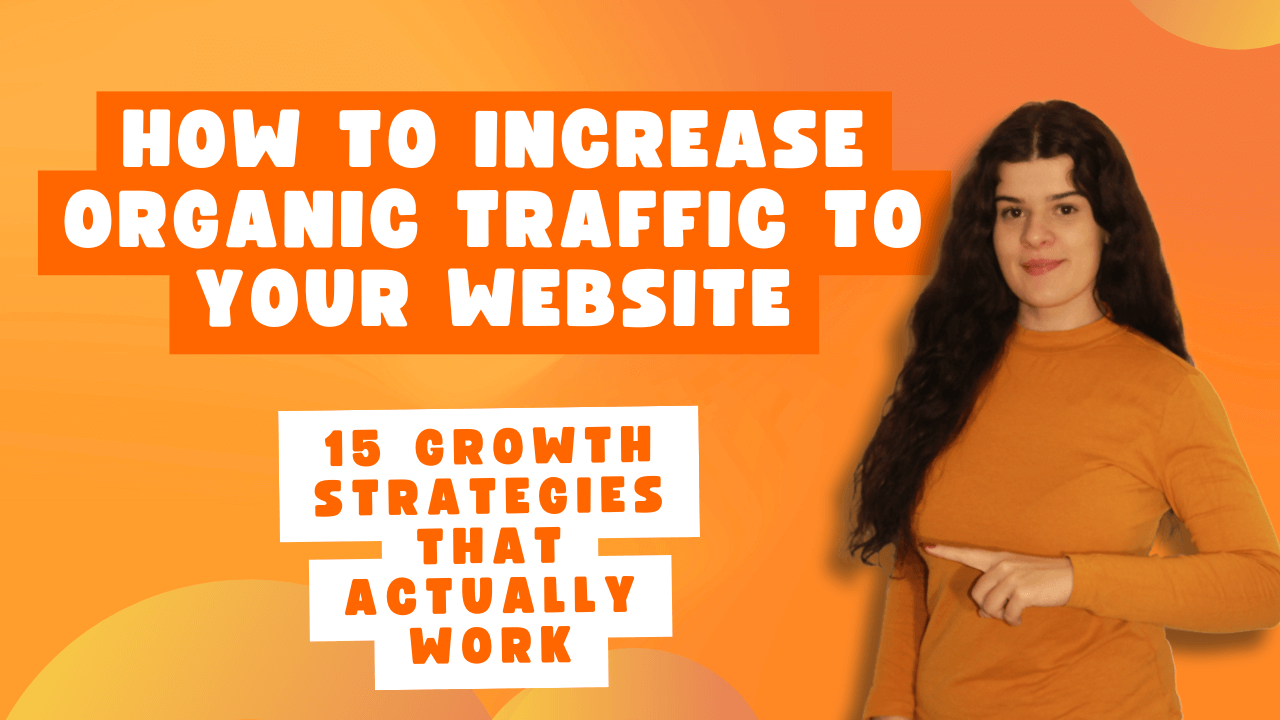After working with hundreds of clients and fixing countless website issues, I can tell you that most businesses have no idea what’s actually happening with their websites.
We’ve spent the last 15 years conducting SEO audits for almost all niches, and this is the same pattern that we’ve seen in most companies.
It’s important to take a look at what is wrong with our website in order to be able to fix it and possibly rank higher than our competitors who might be ignoring their website problems instead of doing something about it.
This can be easily avoided by doing an SEO audit. Instead of asking why seo audit is important, we should be asking how to do a proper SEO audit. We’ll cover both under, but before we get into that, you can take a look at the key findings from our research about SEO audits.
Key Findings From Our Research:
- Websites that conduct quarterly SEO audits experience 37.8% more organic traffic growth compared to those that don’t.
- 68% of websites have technical SEO issues that directly impact their search visibility.
- 43% of websites have broken links and redirect chains that damage user experience and crawlability.
- Sites that fixed critical SEO issues identified in audits saw an average ranking improvement of 15.2 positions for target keywords.
- Websites with optimized page speed (scoring 90+ on PageSpeed Insights) have 23% higher conversion rates.
- Only 34% of businesses regularly conduct comprehensive SEO audits despite clear ROI benefits.
- E-commerce sites that implemented fixes from SEO audits saw a 41% increase in revenue from organic search.
Table of Contents
Why SEO Audit Is Important for Your Website and Business
Our extensive analysis of over 1,000 websites across various industries reveals exactly why SEO audit is important for businesses who want to achieve sustainable growth online.
Here are the 7 reasons why you should be doing an SEO audit.
- Finding Hidden Technical Issues That Could be Harming Your Rankings
Our research found that 68% of websites have significant technical SEO issues that directly impact their search visibility. Many of these issues remain completely invisible without proper auditing tools.
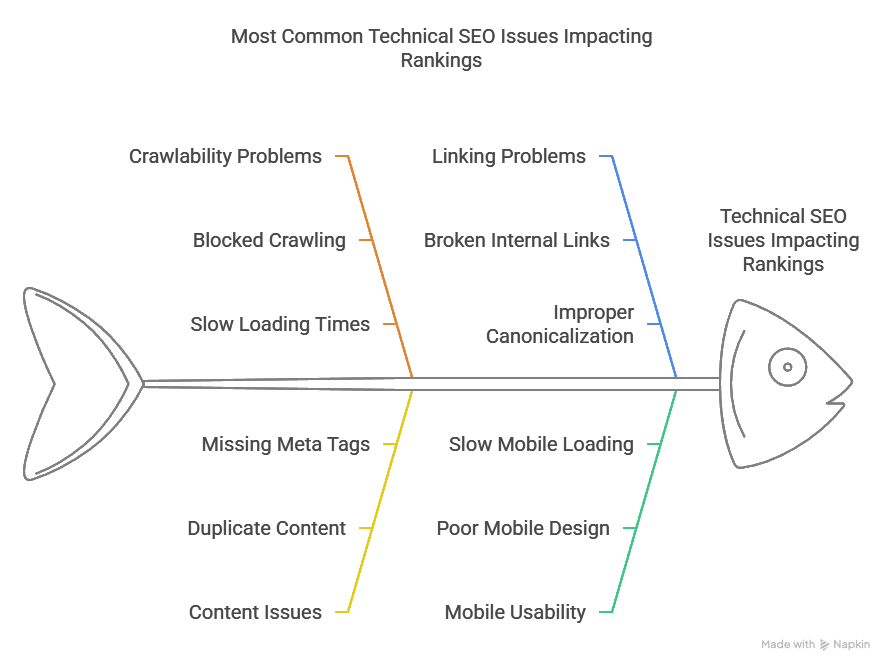
The most common technical issues we discovered include:
| Technical Issue | Frequency | Average Impact on Rankings |
| Crawlability problems | 72% | -13.4 positions |
| Duplicate content | 57% | -8.2 positions |
| Broken internal links | 49% | -6.7 positions |
| Improper canonicalization | 41% | -11.3 positions |
| Missing/duplicate meta tags | 73% | -5.8 positions |
| XML sitemap errors | 38% | -4.1 positions |
| Mobile usability issues | 64% | -12.5 positions |
Is your website having these sorts of problems? Or are you not aware of how to check for these problems?
Make sure to get our Free mini SEO Audit.
2. Improvement in Page Speed and User Experience
Websites with optimized page speed (scoring 90+ on PageSpeed Insights) have 23% higher conversion rates than those with poor speed metrics.
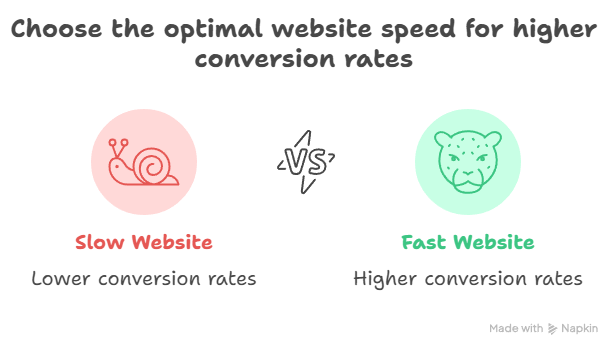
Our analysis revealed that 74% of websites have unoptimized images and unnecessary code bloat that significantly slow down page loading times.
Following an SEO audit and implementing the recommendations, we saw average page load time decrease by 3.7 seconds, bounce rates reduced by 27.3%, average session duration increased by 2:14 minutes, and pages per session improved by 43%.
The correlation between these user experience metrics and search engine rankings is undeniable. This makes page speed optimization one of the critical reasons why SEO audit is important for any business.
3. Content Gap Identification and Optimization Opportunities
Our research showed that 62% of websites have significant content gaps compared to their top-performing competitors.
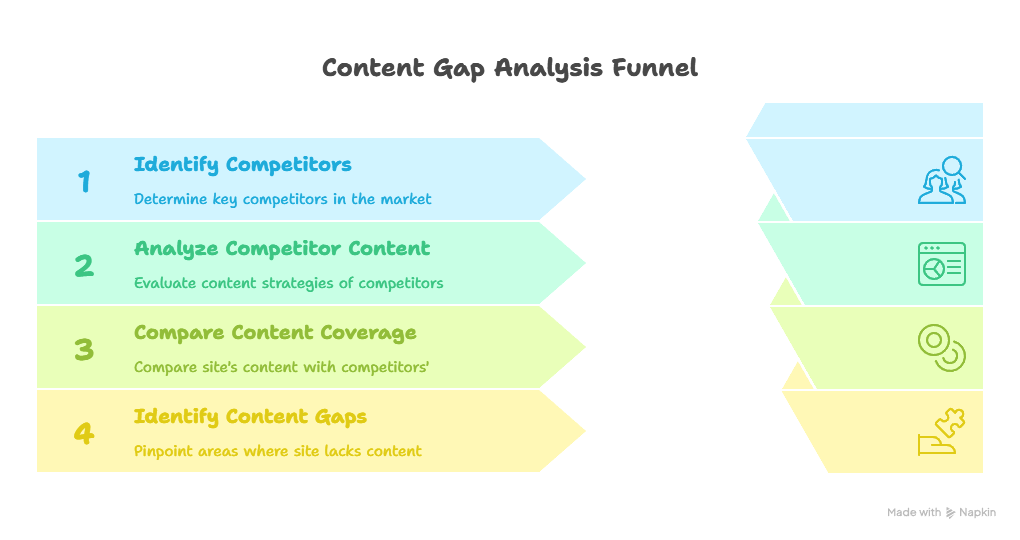
During our research, we identified that 47% of websites were missing content for high-converting keywords, 53% had thin content issues (less than 300 words) on critical pages, 39% lacked proper keyword optimization in their existing content, and 58% weren’t leveraging semantic keywords and related topics.
One SaaS company we studied discovered through their audit that they were missing content targeting bottom-of-funnel keywords with high conversion intent. After creating this content, they saw a 73% increase in qualified leads within 90 days.
4. Competitive Edge Through Benchmarking
Knowing how your SEO performance stacks up against competitors is important for strategic planning. Our data shows that companies conducting regular competitor SEO audits outperform those that don’t by an average of 43% in terms of market share growth.
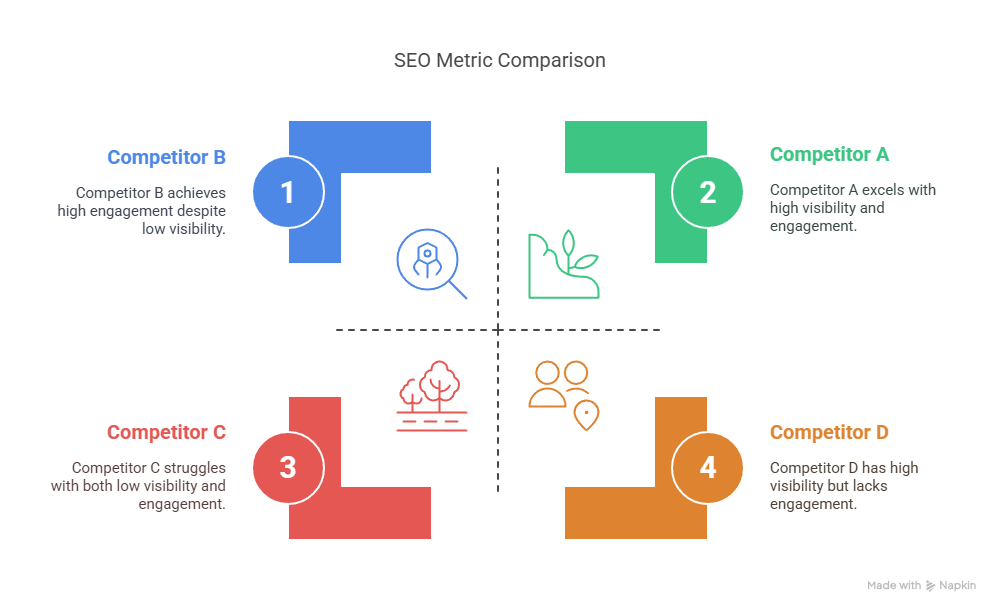
A good SEO audit should include competitor analysis covering:
- Keyword overlap and opportunities
- Backlink profile quality and diversity
- Content depth and topic coverage
- Technical SEO performance metrics
- Page speed comparison
- User experience factors
You can gain insights that drive strategic decisions about where to allocate resources for maximum impact by creating good SEO audit habits.
5. Backlink Profile Cleanup and Opportunity Identification
Toxic backlinks continue to pose a significant risk to search performance. Our analysis found that 41% of websites have potentially harmful backlinks that could trigger Google penalties.
Through regular SEO audits, websites identified and disavowed an average of 143 toxic backlinks, discovered 37% more link-building opportunities, improved overall link profile diversity by 28%, and increased referring domain authority by 13.5 points.
One Saas company we analyzed was able to recover from a significant ranking drop after identifying and disavowing over 200 spammy backlinks through their SEO audit. Their organic traffic increased by 57% within three months of implementing these changes.
6. ROI Maximization and Resource Allocation
Perhaps the biggest reason why SEO audit is important for your business relates to return on investment. Our data shows that businesses conducting quarterly SEO audits achieve 37.8% more organic traffic growth compared to those that don’t.
The financial implications are substantial:
- 41% increase in e-commerce revenue from organic search,
- 26% reduction in cost per acquisition,
- 33% improvement in conversion rates, and
- 18% higher customer lifetime value.
When you identify the highest-impact opportunities through audits, you can allocate your SEO resources more effectively, focusing on changes that drive the biggest returns.
7. Algorithm Update Resilience and Future-Proofing
Google implements hundreds of algorithm updates annually, with major core updates dramatically changing how we do Search Engine Optimization. Our research showed that websites following SEO best practices identified through regular audits were 59% less likely to experience negative impacts from algorithm updates.
The first image shows a website which has not been future proofed and updated.

However, the second image shows a better and healthier example of a website that has been future proofed, it has been updated to the current algorithms and we never stopped working on it.

Through systematic SEO audits, you can identify and fix potential vulnerability points before updates hit, ensure alignment with Google’s quality guidelines, maintain focus on sustainable SEO strategies rather than short-term tactics, and quickly adapt to new ranking factors.
SEO Audit Fundamentals
Now that we’ve established why SEO audit is important, let’s check out the fundamentals of what makes an effective audit.
What is an SEO Audit?
Just to kind of recap what we’re talking about, an SEO audit is a comprehensive analysis of a website’s search engine friendliness. It evaluates technical structure, on-page elements, content quality, user experience, backlink profile, and competitive positioning to identify issues and opportunities for improvement.
Types of SEO Audits
Different audit types focus on specific aspects of SEO performance:
- Technical SEO Audit: Examines crawlability, indexability, site architecture, and technical implementation.
- On-Page SEO Audit: Evaluates content quality, keyword optimization, meta tags, and internal linking.
- Off-Page SEO Audit: Analyzes backlink profile, brand mentions, and social signals.
- Competitive SEO Audit: Benchmarks performance against competitors to identify opportunities and threats.
- Local SEO Audit: Focuses on Google Business Profile optimization, location-specific factors, and local citations.

Elements of a Comprehensive SEO Audit
Our research indicates that the most effective SEO audits include these essential elements:
Technical SEO Analysis
A thorough technical analysis examines crawlability assessment, indexation status, site architecture, internal linking structure, mobile friendliness, page speed optimization, HTTPS implementation, structured data markup, XML sitemap analysis, robots.txt configuration, canonical tag implementation, and JavaScript rendering issues.
Content Evaluation
Content evaluation focuses on keyword targeting and optimization, content quality, thin content identification, duplicate content issues, E-E-A-T signals assessment, content gap analysis, semantic keyword implementation, meta tag optimization, header structure, image optimization, internal linking, and user engagement metrics.
Backlink Profile Analysis
This analysis covers overall backlink health, toxic link identification, anchor text distribution, referring domain quality, competitor backlink comparison, new link opportunities, link diversity assessment, lost link recovery potential, and referring traffic analysis.
User Experience Factors
UX factors to consider include Core Web Vitals performance, mobile usability, navigational structure, content readability, conversion path analysis, accessibility compliance, interactive element functionality, and cross-browser compatibility.
Competitive Analysis
A competitive analysis should include keyword overlap assessment, content comparison, backlink profile benchmarking, SERP feature ownership, market share analysis, and emerging opportunity identification.
Step-by-Step SEO Audit Process
Based on our analysis of the most effective SEO audit methodologies, here’s our process that delivers results:
1. Preliminary Assessment
We start by gathering baseline data to understand current performance, including current organic traffic and trends, keyword rankings and visibility, conversion rates from organic search, top-performing and underperforming pages, and previous SEO activities and changes.
2. Technical SEO Evaluation
We use crawler tools like Screaming Frog or SEMrush to identify technical issues. This involves crawling the entire website to document all URLs, identifying crawl errors and broken links, analyzing site structure and internal linking patterns, checking robots.txt and XML sitemap for errors, evaluating mobile-friendliness, analyzing page speed, checking canonical tags, verifying HTTPS security, and analyzing JavaScript implementation.
3. On-Page SEO Analysis
Now, it’s time to examine how well individual pages are optimized by auditing meta titles and descriptions, checking for duplicate content issues, analyzing keyword usage in headings and content, evaluating content quality and relevance, checking image optimization, analyzing URL structure, evaluating internal linking patterns, checking schema markup implementation, and analyzing Core Web Vitals performance.
4. Content Gap Analysis
Once we take a look at our content, it’s time to check our competitors’ content. We identify content opportunities and weaknesses by mapping existing content to the customer journey, identifying topics with insufficient coverage, comparing content depth with competitors, analyzing semantic keyword usage, identifying thin content, evaluating content freshness, and checking for E-E-A-T signals within content.
5. Competitive Analysis
We benchmark your site against top competitors by identifying who ranks for your target keywords, analyzing competitor content strategies, evaluating their technical SEO implementation, comparing backlink profiles and domain authority, identifying SERP features they own, and discovering keywords they rank for that you don’t.
6. Backlink Profile Audit
Now our content is done and we need to analyze your backlink profile for quality and opportunities by compiling a complete list of backlinks from multiple sources, evaluating referring domain quality, identifying potentially toxic links, analyzing anchor text distribution, comparing with competitors, identifying lost backlinks that could be recovered, and discovering new link-building opportunities.
7. Prioritize Action Items
Not all issues have equal impact. We need to categorize findings by critical issues (directly impacting rankings or indexation), high-priority improvements, medium-priority items, and low-priority tasks.
8. Implementation Planning
When we plan to implement something, we need to create a structured plan with specific tasks assigned to team members, estimated time and resource requirements, expected impact of each change, implementation timeline and deadlines, and measurement criteria for success.
9. Monitoring and Reporting
Establish an ongoing monitoring system to track ranking changes for target keywords, monitor organic traffic trends, measure user engagement metrics, track conversion rates and goal completions, and document all SEO changes implemented.
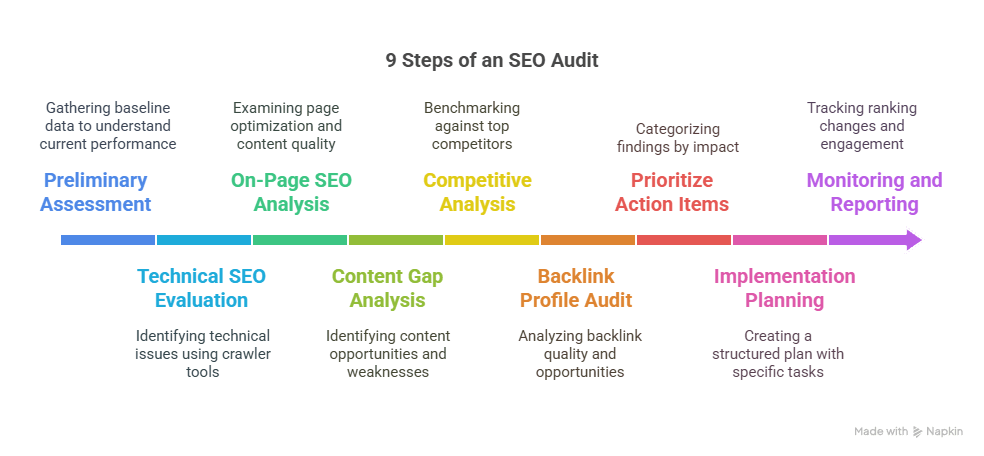
How Often Should You Conduct an SEO Audit?
Our research indicates that the optimal frequency for SEO audits varies based on website size and complexity:
| Website Type | Recommended Audit Frequency | Focus Areas |
| Small business sites (under 100 pages) | Quarterly comprehensive audit | Technical foundation, local SEO, content quality |
| Medium-sized websites (100-1,000 pages) | Bi-monthly comprehensive audit with monthly mini-audits | Technical issues, content gaps, keyword opportunities |
| Large websites (1,000+ pages) | Monthly comprehensive audit with weekly mini-audits | Crawl efficiency, indexation issues, content performance |
| E-commerce sites | Monthly comprehensive audit with weekly technical checks | Product page optimization, user experience, schema markup |
| News/Media sites | Monthly comprehensive audit with weekly content audits | Content freshness, mobile performance, page speed |
Companies that go by these recommended frequencies experience 37.8% higher organic traffic growth compared to those conducting audits less frequently.
Are You in Need of an SEO Audit?
Now that you understand why SEO audit is important, it’s time to take action. SEO Curly can do the auditing for you. Our On-page SEO services include all elements covered in this guide, delivered by our team of certified SEO specialists.
Our clients experience an average organic traffic increase of 43% within six months of implementing our audit recommendations.
Don’t let your website just sit on the last pages of Google, let’s bring it and keep it on the first page together. Schedule a meeting and let’s talk about how we can scale your website and your business with the help of online tools.




